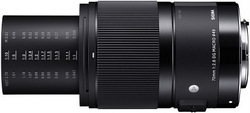Sigma has unveiled the specs of two new Art lenses, the 70mm f/2.8 DG Macro and a fast 105mm f/1.4 DG HSM Art prime lens, which were announced along with seven other lenses at CP+ in February.
The new lineup of lenses are in development, and will be progressively made available.
While Sigma’s announcement provides no ETA or pricing for both lenses, releasing the specs suggests these two lenses will be the first to ship.
The 105mm will be available for Canon, Nikon, Sony E and Sigma mount, while the 70mm will only be available for Canon, Sony E and Sigma mounts.
 70mm f/2.8 DG Macro
70mm f/2.8 DG Macro
Sigma’s first macro Art lens has a coreless DC motor controlled by a new optimised autofocus algorithm, which when combined enhance image quality and noise reduction, and offers smooth and fast autofocus.
The lens has a focus-by-wire system that eliminates the mechanical connection between the focus ring and drive system, making manual focus more precise.
Full-time manual focus allows a photographer to make minute adjustments, even during autofocus, via the focus ring.
The lens is the successor of Sigma’s Macro 70mm f2.8 EX DG. It builds on the predecessors sharp optical performance, with an updated Art line high-end quality finish.
The lens features 13 elements in 10 groups, including a two-group floating focus mechanism to minimise aberrations at any focus distance. Additionally, it has two FLD glass elements to minimise axial chromatic aberration, two SLD elements, and a high refraction index element, along with two aspherical elements to increase resolution at close distance. It can focus within 25.8cm of subjects.
The 70mm macro lens is compatible with Sigma’s USB Dock, macro flash EM-140 DG, and tele converters.
 105mm f1.4 DG HSM Art
105mm f1.4 DG HSM Art
The fast ‘bokeh king’ lens has the longest focal length of the nine f1.4 Art series, and includes an uncommonly large number of optical elements for a prime lens – 17 in 12 groups.
Three FLD glass elements, two SLD glass elements, and one aspherical lens element, combine to create an optical system that minimises axial chromatic aberration to deliver high resolution along with sufficient peripheral light volume.
The focus area is ‘extremely sharp’, in contrast to the out-of-focus area which features a bokeh effect with natural colours making this lens one for the portrait photographers. But Sigma says Sagittal coma flare is under control, making the lens ideal for capturing the night sky.
The lens has a nine-bladed iris diaphragm that closes to a circular aperture. It has dust and splash sealing, with the front element coated in a water and oil repellent.
The lens is bulky, weighing at 1645 grams.





Be First to Comment